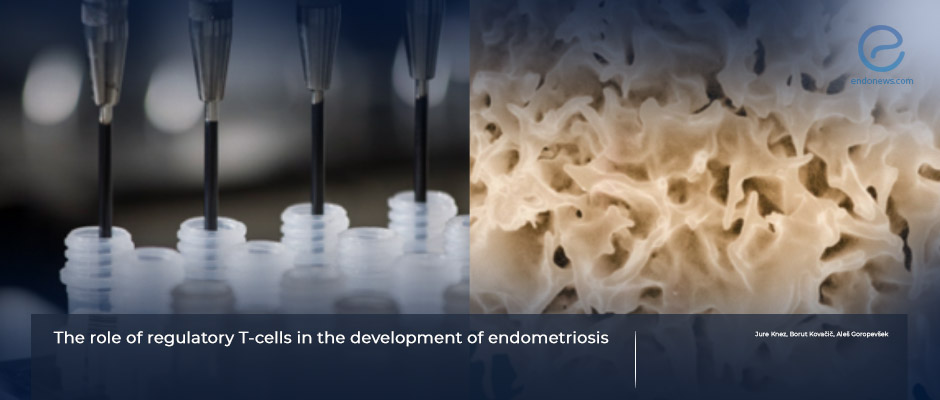Regulatory T cells influence on endometriosis development
Jul 3, 2024
Review study explores mechanisms of Tregs in endometriosis
Key Points
Highlight
- Regulatory T cells (Tregs) have pivotal roles in maintaining immune balance and their potential implications in endometriosis pathogenesis.
Importance
- Understanding the dynamics of Treg cells could help in terms of innovative therapeutic strategies for managing endometriosis.
- Clarifying immune system dysregulation in endometriosis may lead to improvements in both diagnostic and treatment purposes.
What’s done here
- This mini-review evaluates the Treg cell function in the female reproductive tract, focusing on its impact on endometriosis.
- Recent studies and findings concernıng Treg cell involvement in endometriosis progression are analyzed.
Key results
- CD4+FoxP3+ Tregs play a crucial role in maintaining tissue homeostasis through cell contactö and cytokine secretion.
- In ovarian ectopic lesions, IL-10-expressing macrophages and Tregs collaborate to establish an immunosuppressive environment that supports endometriosis.
- Eutopic endometrium in endometriosis patients exhibits a proinflammatory state characterized by increased levels of IL-17, CD8+ T cells, and NK cells.
- Higher levels of FoxP3+ cells in ectopic lesions but lower levels in peripheral circulation in advanced endometriosis cases are shown.
- Variations in FoxP3+ cell levels are observed between peritoneal lesions and controls, with disrupted homeostasis noted in the eutopic endometrium during the secretory phase.
- Interactions between CD86-CTLA-4 on macrophages and Tregs are increased in endometriosis lesions.
- On the contrary, Treg depletion enhances lesion growth in mouse models, indicating a complex role for Tregs in disease progression.
- Pathways involving IL-7 and IL-10 influence Treg homeostasis, potentially contributing to inflammation and fibrosis observed in endometriosis.
Limitations
- Variability in methodologies like immunohistochemistry and cytometry, hormonal fluctuations influencing Treg dynamics during the menstrual cycle, the fact that different types of endometriosis exhibit diverse immunological characteristics and the possibility of Treg distribution and function may vary across different sites are limitations.
Lay Summary
While the exact cause of endometriosis is still debated, various theories are being investigated. One approach focuses on the immune system. Regulatory T-cells (Tregs) are crucial in suppressing inflammatory immune responses and preventing autoimmune diseases, allergies, infections, and cancer.
Knez et al. from Maribor, Slovenia performed a mini-review regarding the roles of Tregs in various places in the female reproductive tract particularly in endometriosis. It was published in the May 2024 issue of the journal Human Reproduction.
They first noted that different subpopulations of Tregs are responsible for different pathways and therefore should be evaluated accordingly. CD4+FoxP3+ Tregs are key in maintaining tissue homeostasis through cell contact and cytokine secretion. In ovarian ectopic lesions, IL-10-expressing macrophages and Tregs create an immunosuppressive environment that supports endometriosis. Conversely, the eutopic endometrium in endometriosis patients exhibits a proinflammatory state with increased IL-17, CD8+ T cells, NK cells, and Tfh cells, resembling immune shifts seen in autoimmune diseases like SLE and Sjögren’s syndrome.
Regarding Treg cells' role in endometriosis development, similarities to cancer-related mutations (e.g., KRAS, PIK3CA, PTEN) have been observed. Studies in animal models indicate higher levels of FoxP3+ cells in ectopic lesions but lower levels in peripheral circulation in advanced endometriosis cases. Recent research highlights complex findings about FoxP3+ cells, including varying levels in peritoneal lesions versus controls and disrupted homeostasis in eutopic endometrium, particularly in the secretory phase. Studies also report altered CD25+FoxP3+ cell percentages in peritoneal fluid versus peripheral blood, with higher peritoneal fluid levels linked to advanced disease stages. The authors also discuss recent discoveries, such as increased interactions between CD86-CTLA-4 on macrophages and Tregs in endometriosis lesions, contrasting with findings suggesting Treg depletion enhances lesion growth in mouse models. Dysregulation of aTregs in ovarian lesions, with higher concentrations during the secretory phase, contrasts with increased FoxP3+ cells in eutopic endometrium, where non-Treg fractions lack suppressive activity. Additionally, pathways involving IL-7 and IL-10 influence Treg homeostasis, potentially contributing to inflammation and fibrosis in endometriosis.
Authors conclude that while Treg cells and their subsets show promise in understanding endometriosis, further research with standardized methodologies and larger cohorts is essential to elucidate their precise roles in disease pathogenesis and progression.
Research Source: https://pubmed.ncbi.nlm.nih.gov/38756099/
endometriosis regulatory T cells Tregs immune system

